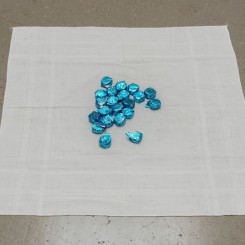This piece is included in Ran Dian’s print magazine, spring-summer 2017 issue
Why Felix Gonzalez-Torres, and why now? What are the nuanced relationships to identity and aesthetics we could distill from his oeuvre that might help us contribute to social change? I ask these questions in the spirit of the late Cuban-born American artist who believed deeply in art’s fateful purpose, that “it either furthers and helps the master narrative or it tries to disrupt it.”(1) I want to discuss the potential for his work to contribute to current social critique, and hopefully bring about a genuine renewal of his art and thinking.
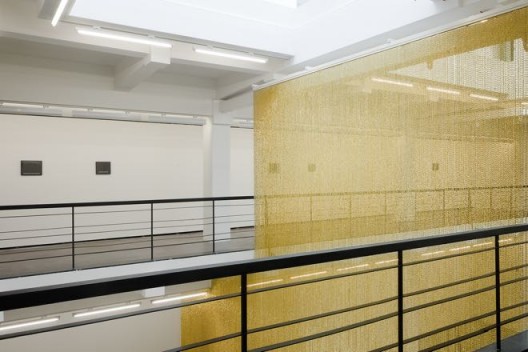
费利克斯·冈萨雷斯-托雷斯,《“无题”》(金),串珠和悬挂装置,尺寸可变,1995年。“费利克斯·冈萨雷斯-托雷斯”,展览现场。上海外滩美术馆。2016年9月30日–12月25日。策展人:拉瑞斯·弗洛乔,李棋。© 费利克斯·冈萨雷斯-托雷斯基金会。纽约安德烈娅·罗森画廊惠允 / Felix Gonzalez-Torres, “Untitled” (Golden), strands of beads and hanging device, dimensions vary with installation, 1995. Installation view: Felix Gonzalez-Torres. Rockbund Art Museum, Shanghai, China. 30 Sep. – 25 Dec. 2016. Curs. Larys Frogier and Li Qi. © The Felix Gonzalez-Torres Foundation. Courtesy of Andrea Rosen Gallery, New York
Gonzalez-Torres’ recent retrospective at the Rockbund Museum of Art in Shanghai (his first institutional show in Mainland China) spanned three months—three months that turned out to be historic, especially when seen from the vantage point of inflamed politics in the United States, a place the artist called home from 1979 until his premature death in 1996. In hindsight, several socio-political events which either preceded or collapsed during the exhibition period seemed to have drawn us closer to a neo-reactionary era which informed much of Gonzalez-Torres’ practice. The retrospective opened less than four months after the deadliest incident of crime against (Latino) GLBT people in American history which, thanks to the internet and social media, also stirred up widespread debates about GLBT rights in China. Even if one insisted on overlooking the social implications of this brutal hate crime, the win that followed by an impetuous demagogue in the 45th US presidential campaign in early November would perhaps finally declare a reality that, while alien to some, is absolutely not new. It calls to mind Gonzalez-Torres’ warning in a 1993 interview: “[T]he reactionary forces that ruled us for the last twelve years are still very active, just waiting to strike back and impose once more their agenda of homophobia, sexism, racism, and divisiveness. Their exclusionary practices are being perfected as we speak.”(2)
I believe this sense of foreboding which suffocates us today echoes, to some extent, the bleakness of 1980s and early 1990s America, a time marked by what Gonzalez-Torres summarized as “trickle-down economics, a rise in cynicism, growing racial and class tension, and the widening gap between the very rich and the rest of us.”(3) These social factors that shook the artist awake from his romanticization of the “American Dream” are all too familiar to us today. Caught up in these very circumstances as well as the AIDS pandemic, it was also during this time that the artist called for a “guerrilla war” through an aesthetic strategy that combined a formal symbolic lexicon with activist politics—tough yet oblique, evocative but never maudlin, traversing manifold affective circuits. Successfully infiltrating the public consciousness, it also paled much of the sensationalizing and moralizing work that was created around similar themes at the time, the ubiquity of which only serves to critique its own exploitation. One aspect of such phenomena has been hilariously described by the contemporary sculptor Gordon Hall as “the glitter problem…or the leather problem. Or the pink-yarn, 1970s crafts, iconic-diva, glory-hole, pre-AIDS-sexuality, post-AIDS-sexuality, bodies and body parts, blood-and-bodily-fluids problem.”(4)
To be sure, Gonzalez-Torres’ work, as rightly emphasized in the exhibition brochure, does not “simply deal with homosexual issues or the AIDS crisis” and “lacks a univocal order.”(5) To underline any singular aspect of his cultural formation is to ignore the artist’s ardent critique of dominant ideologies in their calls for reductive structures of identity and identification. He frequently defended this agenda in interviews. When Tim Rollins brought up popular criticism about the lack of overt political or Latino content in his work, Gonzalez-Torres replied: “Some people want to promote multiculturalism as long as they are the promoters, the circus directors. We have an assigned role that’s very specific, very limited. As in a glass vitrine, ‘we’—the ‘other’—have to accomplish ritual, exotic performances to satisfy the needs of the majority. This parody is becoming boring very quickly. Who is going to define my culture? It is not just Borges and Garcia Marquez, but also Gertrude Stein and Freud and Guy Debord—they are all part of my formation.”(6) While it is undeniable that the AIDS pandemic and homosexual desire left a mark on Gonzalez-Torres’ practice, none of their effects could be deemed more potent than the others. His intersecting horizons of experience—be it ethnic (being born into a Cuban family and having emigrated to America at a young age), ideological (his reading of Brecht, Althusser, and other canonical works of literature and Marxist theory), professional (navigating the art world), or emotional (his experience of love and loss)—gave rise to a multitude of inextricable contradictions in his identity, something the artist naturally became aware of, reflected upon, and finally affirmed through his work.
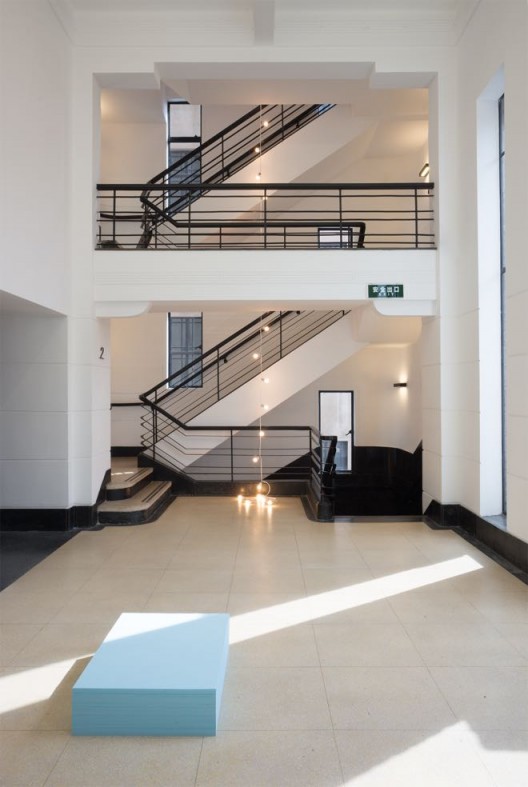
费利克斯·冈萨雷斯-托雷斯,《“无题” 》(情郎),蓝色纸张,数量无限,理想高度 7 1/2英寸 × 29 × 23 英寸(原纸尺寸)1990年 (前); 费利克斯·冈萨雷斯-托雷斯,《“无题” 》(北),灯泡、瓷灯口、电线,12组,总尺寸可变,1993年 (后)。“费利克斯·冈萨雷斯-托雷斯”,展览现场。上海外滩美术馆。© 2016年9月30日–12月25日。策展人:拉瑞斯·弗洛乔,李棋。© 费利克斯·冈萨雷斯-托雷斯基金会。纽约安德烈娅·罗森画廊惠允 / Felix Gonzalez-Torres, “Untitled” (Loverboy), blue paper, endless supply, 7 1/2 in. at ideal height x 29 x 23 in. (original paper size), 1990 (foreground); Felix Gonzalez-Torres, “Untitled” (North), light bulbs, porcelain sockets and extension cords, twelve parts: overall dimensions vary with installation, 1993 (background). Installation view: Felix Gonzalez-Torres. Rockbund Art Museum, Shanghai, China. 30 Sep. – 25 Dec. 2016. Curs. Larys Frogier and Li Qi. © The Felix Gonzalez-Torres Foundation. Courtesy of Andrea Rosen Gallery, New York
This affirmation is highlighted by the formal hybridity which Gonzalez-Torres insisted on in his practice. From large-scale public billboards exposing intimate domestic environments (“Untitled”, 1995) to a performance installation that flashes a snippet of lowbrow gay nightlife with all its exhibitionism and narcissism in an art institution, disrupting its solemnity (“Untitled” [Go-go Dancing Platform], 1991) and jigsaw puzzle works piecing together fragmented images from his childhood memory (“Untitled” [Madrid 1971], 1988) to ostensibly minimalist sculptures consisting of mass-market objects such as strands of beads or strings of light bulbs (such as “Untitled” [Chemo], 1991; and “Untitled” [North], 1993), his body of work traverses an expanded range of materials. But it doesn’t stop there. Each individual work, within its minimal construct, also presents a conceptual riddle that defies reduction. Take Gonzales-Torres’ famous stacked pieces, for instance: each of them consists of an endless supply of paper of a specific dimension, to be maintained at a specified height throughout every episode of its public display. Visitors are allowed to take away as many of these pieces of paper as they wish, although the invitation is never publicly disclosed. Prima facie, the shape of these stacks may be reminiscent of minimalist cubes as seen in numerous works by the likes of Donald Judd, Carl Andre and Robert Morris; but, when approached from a two-dimensional perspective, they immediately adopt a pictorial form (that which early minimalism deliberately retreated from), becoming portraits, even frames from a film. Meanwhile, their ephemerality and participatory nature further reflects an engagement with process art as well as performance. This stunning ambiguity eclipses Judd’s valorization of a specific object’s wholeness in a single form, and improves on Morris’ positioning of the minimalist aesthetic in the interaction between the work, the particular space and the active viewer by turning away from the gestalt and restoring to the work an intimacy that Morris rejected. Allowing more physical forms of interaction with the viewer, Gonzalez-Torres’ work breaks away from early minimalism’s self-referentiality and invites each viewer into a state of liminality where one negotiates with the art object in fluid, non-essential terms.
To further expound on this conceptual and formal openness, it is imperative that we turn to Gonzalez-Torres’s conviction that aesthetics are politics and to his “guerrilla war” metaphor.(7) This means that his preoccupation with and appropriation of minimalist language must be considered beyond matters of taste or natural art-historical progression, and instead as amounting to a tactic intentionally deployed for socio-political ends. Considering the conservative political climate that shrouded the years of Gonzalez-Torres’ practice and the history of minimalism’s complicity with non-representation, one can read his minimalist features as a drag performance that allowed him to successfully enter the mainstream cultural conversation without being held captive by the state regime. This is most evident in the paradoxical titles of his work, in which parenthetical labels, protected behind an official status of titleless-ness, only covertly thrusts at the public for acknowledgement. An attentive viewer may discover the arrangement of stigmatized experiences his work connotes, but if any conservative-minded politician seeks ways to close down a Gonzalez-Torres show, like Senator Stevens did at the artist’s Hirshhorn exhibition back in 1994, one would have a hard time finding a trace of obscenity.
A more discreet—and to me remarkably provocative—layer in Gonzales-Torres’ strategy of non-representation conceals a perceptive critique of identity politics and his proposed solution. It harks back to his view of identity as non-unifiable, often marked by contradictions, and the act of identification as always already a masked regulation of the state apparatus which ultimately bolsters the existing social order while deferring discussions of more complicated processes of self-formation. His famous installation “Untitled” (Portrait of Ross in L.A) consists of a pile of candy of what can be interpreted as an ideal weight for the man named in its title. The sculpture contains no figures, no gendered metaphor, no culturally specific object—not a trace of visual representation that allows for readings pertaining to identity. Only the parenthetical title reveals a person, possibly male, one the artist was so fond of he created something to memorialize him. Note that Gonzalez-Torres never shied away from speaking in interviews about his male partner, Ross, who died of AIDS in 1991, and yet he insisted his work was never about being gay—an identity signifier—but about his love for another person, and the loss of desire. In this work, an episode of love is invoked through a formally malleable sculptural body made of everyday objects which, while freely available to viewers, resist identification with any of the specifics of his and his lover’s experiences. This withdrawal from simply invoking identity is a quiet yet radical gesture of refusal to participate in a representational economy—not even by countering its negativity with positive representational alternatives. It has been adeptly theorized by the late Cuban-American queer scholar José Esteban Muñoz as a performance of “disidentity” that liberated the artist and his work from a dead-end street.(8) When anyone takes a piece of candy, consumes it in their own body, or puts it back into the pile, one is encouraged to liberate oneself from the original maker’s narrative, becoming an active agent in negotiating the meaning of the art object and one’s own identity. Through these acts of reciprocation, our imagination of the very notion of identity thickens and melts with every new permutation of the work, winding up in an intrapersonal and interpersonal mesh that expands and reinforces our sameness unceasingly.
The politically charged and personal nature of Gonzalez-Torres’ art was deeply rooted in the artist’s historical context. Making art in a time when homosexuality could hardly be hidden amid the sweeping AIDS epidemic and which often became the identifying characteristic of an artist, Gonzalez-Torres’ appropriation of minimalist language and performance of disidentification was remarkably original and tactical in pushing forward social movement. But as the AIDS epidemic became part of the past, the same logic of appropriation continued, albeit to an opposite end. In an 2010 article titled “Notes on Gay Minimalism,” Tyler Considine traces the diffusion of Gonzalez-Torres’ “guerrilla warfare” into, much against the artist’s intention, a motion-less “contemporary gay minimalism” prevalent in realms of art, fashion and design, capitalizing on a depoliticized minimalist aesthetic and a “casual” invocation of identity as its most assured characteristics.(9) The turn of events in the global political arena in 2016 should perhaps incite active practitioners in contemporary art and activism, adorned with the luxuries fought for by previous generations, to rethink the aesthetic in the political and to think through the trappings of identity politics. And the matter is more pressing for China. The increasing “visibility” of non-heterosexual sexualities, even non-normative gender expressions, in media are so easily depoliticized that it often produce legible self-identification as their price of admission, deferring concrete social changes. As accelerating capitalism breeds depoliticized practices and reductive representational economy across first-tier cities in China, Gonzalez-Torres’ retrospective offers generous lessons to seep into the attentive viewer’s consciousness.
(1) “An interview with Felix Gonzalez-Torres by Tim Rollins,” edited by Frances Colpitt, A.R.T. Press: 1993.
(2) Ibid.
(3) Felix Gonzalez-Torres, “1990: L.A., ‘The Gold Field’,”
(4) Gordon Hall, “Object Lessons: Thinking Gender Variance Through Minimalist Sculpture,” XXXXX
(5) Quoted from the exhibition brochure.
(6) “An interview with Felix Gonzalez-Torres by Tim Rollins,” Originally published by A.R.T. Press, 1993. Edited by Frances Colpitt.
(7) Gonzale-Torres’ statement, “[A]s we know aesthetics are politics. They’re not even about politics, they are politics,” was published in “FELIX GONZALEZ-TORRES: ETRE UN ESPION,” a 1995 interview of the artist by Robert Storr.
(8) José Esteban Muñoz, Disidentifications: Queers of Color and the Performance of Politics, University of Minnesota Press: 1999.
(9) Tyler Considine, “Notes on Gay Minimalism,” ARTWRIT Vol 3: Summer 2010, web.
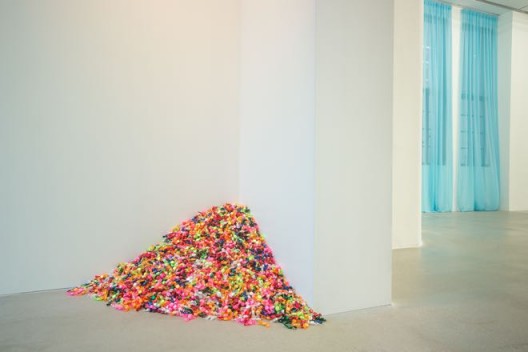
费利克斯·冈萨雷斯-托雷斯,《“无题” 》(罗斯在洛杉矶的肖像), 糖、彩色玻璃包装纸,数量无限,总尺寸可变,理想重量:175磅,1991年。“费利克斯·冈萨雷斯-托雷斯”,展览现场。上海外滩美术馆。2016年9月30日–12月25日。策展人:拉瑞斯·弗洛乔,李棋。© 费利克斯·冈萨雷斯-托雷斯基金会。Felix Gonzalez-Torres, “Untitled” (Portrait of Ross in L.A.), candies individually wrapped in multicolored cellophane, endless supply, overall dimensions vary with installation, ideal weight: 175 lbs, 1991 (left). Installation view: “Felix Gonzalez-Torres”. Rockbund Art Museum, Shanghai, China. 30 Sept. – 25 Dec. 2016. Curs. Larys Frogier and Li Qi. © The Felix Gonzalez-Torres Foundation. Courtesy of Andrea Rosen Gallery, New York
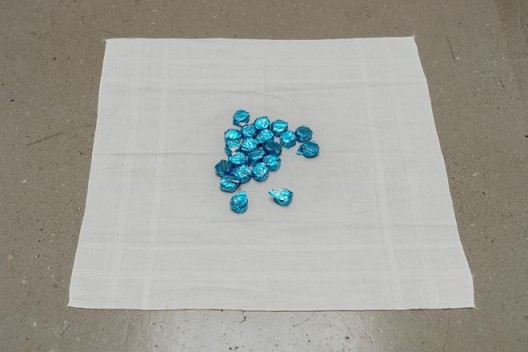
费利克斯·冈萨雷斯-托雷斯,《“无题” 》(咽喉), 手帕、止咳糖、白蓝色玻璃纸包装, 数量无限,总尺寸可变,理想高度 1½ 英寸 × 16 × 16 英寸,1991 年。“费利克斯·冈萨雷斯-托雷斯”,展览现场。上海外滩美术馆。2016年9月30日–12月25日。策展人:拉瑞斯·弗洛乔,李棋。© 费利克斯·冈萨雷斯-托雷斯基金会。纽约安德烈娅·罗森画廊惠允 / Felix Gonzalez-Torres, “Untitled” (Throat), detail, handkerchief and cough-drops individually wrapped in white-and-blue cellophane, endless supply, overall dimensions vary with installation, 1 1/2 in. at ideal height x 16 x 16 in. Installation view: Felix Gonzalez-Torres. Rockbund Art Museum, Shanghai, China. 30 Sept. – 25 Dec. 2016. Curs. Larys Frogier and Li Qi. © The Felix Gonzalez-Torres Foundation. Courtesy of Andrea Rosen Gallery, New York
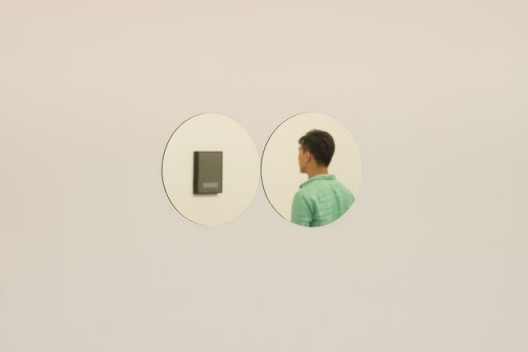
费利克斯·冈萨雷斯-托雷斯,《“无题” 》(三月五日)#1,镜,12 × 24英寸,两件:每件直径12英寸,1991年。“费利克斯·冈萨雷斯-托雷斯”,展览现场。上海外滩美术馆。© 2016年9月30日–12月25日。策展人:拉瑞斯·弗洛乔,李棋。© 费利克斯·冈萨雷斯-托雷斯基金会。纽约安德烈娅·罗森画廊惠允
Felix Gonzalez-Torres, “Untitled” (March 5th) #1, mirror, 12 x 24 in. overall, two parts: 12 in. diameter each, 1991. Installation view: Felix Gonzalez-Torres. Rockbund Art Museum, Shanghai, China. 30 Sept. – 25 Dec. 2016. Curs. Larys Frogier and Li Qi.
© The Felix Gonzalez-Torres Foundation. Courtesy of Andrea Rosen Gallery, New York
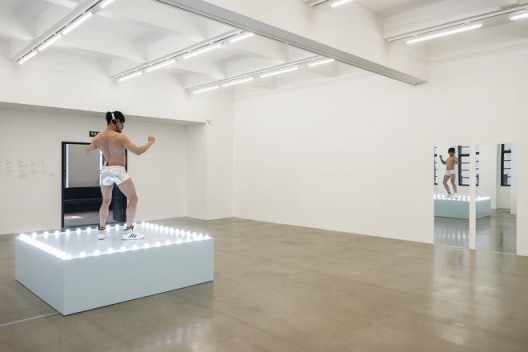
费利克斯·冈萨雷斯-托雷斯,《“无题”(摇摆舞台)》,1991年。木、灯泡、丙烯涂料,摇摆舞者穿着银丝短裤、运动鞋,携带个人音乐设备。总尺寸可变。舞台 21 1/2 × 72 × 72 英寸。展览现场。上海外滩美术馆。© 费利克斯·冈萨雷斯-托雷斯基金会。纽约安德烈娅·罗森画廊惠允 / Felix Gonzalez-Torres, “Untitled” (Go-Go Dancing Platform), 1991. Wood, lightbulbs, acrylic paint and Go-Go dancer in silver lamé bathing suit, sneakers and personal listening device. Overall dimensions vary with installation. Platform: 21 1/2 x 72 x 72 in. Installation view at Rockbund Art Museum. © The Felix Gonzalez-Torres Foundation. Courtesy of Andrea Rosen Gallery, New York

